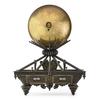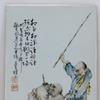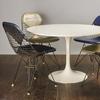LARK MASON CELEBRATES ASIA WEEK NEW YORK WITH A PREVIEW OF HIS IMPORTANT ASIAN, ANCIENT & ETHNOGRAPHIC WORKS OF ART SALE, MARCH 15-22 227 EAST 120TH STREET
- NEW YORK, New York
- /
- March 12, 2013
New York: A preview of the iGavel online auction of important Asian, Ancient & Ethnographic works of art will take place during Asia Week New York, March 15-22, it was announced by Lark Mason, founder and president of the Harlem-based auction house, at 227 East 120th Street. Over 400 lots, drawn from a cross-section of periods and disciplines, will be offered in the online sale goes live on April 17 to May 1.
"I am pleased to preview a wide variety of freshly offered Asian items including bronzes, paintings, furniture, scholars' articles, and ceramics during Asia Week New York," says Lark Mason, who created the highly successful online auction platform in 2003. “Our estimates allow both seasoned and novice collectors to purchase quality works of Asian art.”
The sale’s top ten highlights include:
*Chinese Ancestor Portrait, Color Inks on Silk, 19th century
Ancestor portraits are common in China but those of such extraordinary large size are unusual. The sitter of this portrait is unidentified, but clearly an individual of importance and high rank. (Est. $150,000/250,000)
* Chinese 'Three Friends' Rhinoceros Horn Libation Cup, 17th/18th century
Libation cups of this type were carved in China to give to scholars as a gift once they passed their civil exams. This particular cup incorporates a scholarly motif called the ‘Three Friends of Winter’ the pine, bamboo and plum tree, which symbolize Confucian ideals of perseverance and integrity.
(Est. $80/000/120,000)
* Chinese Archaistic Rhinoceros Horn Libation Cup, 17th/18th century Rhinoceros horn carvings in China are valued due to the symbolism Chinese culture associates with both the horn and the rhinoceros, including strength, power and wealth. Sometime before the Tang Dynasty, the Chinese came to believe that the rhino horn contained magical powers, and because of that it was included as part of the eight Taoist Treasures. The Chinese also for centuries ground the horns to create medicine. This particular example draws upon ancient Chinese bronze decorative elements, emphasizing antiquity and the connection with the present and the long history of Chinese civilization. (Est. $70,000/100,000)
* Chinese Archaic Bronze Vessel, Gui, Western Zhou Dynasty Est.
Chinese bronze ritual vessels from the Western Zhou period are among the most dramatic and beautiful examples of Chinese art. This vessel is called a Gui and it was used for food offerings. Some ancient bronzes are accompanied by inscriptions, such as this example, which is cast with an inscription on the center of the interior. While inscriptions were rare on Shang dynasty bronzes, they became a little more commonplace during the Zhou period, and have become a help to modern historians in understanding values of the time, or social or historical events. The fine quality casting and beautiful patina in tones of grey, brown, and green make this an exceptional example. (Estimate: $40,000/60,000)
* Chinese Porcelain Underglaze Blue and Copper Red Decorated Meiping Vase, 18th century
The provenance of this vase includes Yamanaka & Co, and was sold in 1943 in the sale ‘Collection of Chinese and Other Far Eastern Art.’ Yamanaka was the preeminent Asian art dealer of the late 19th and early 20th centuries with galleries in Asia, London, and several American cities. His galleries had some of the finest examples of Chinese art, and a client list that included Prince Kung. This vase is unusual for its large size and bold decoration, which is usually reserved for much smaller examples. (Estimate: $20,000/30,000)
* Chinese Porcelain Green-Ground Famille Rose Jar, Jiaqing Mark and Period
This jar demonstrates the fine overglaze enameling that Chinese artisans developed on porcelains during the Qing dynasty. The artist included a shou character which means ‘longevity’, peaches, also a symbol for longevity and a Buddhist endless knot representing the spiritual path. (Estimate: $10,000/15,000)
* Mughal Ivory and Tortoiseshell Cabinet, 17th century
The Mughal Empire, established by descendants of Genghis Khan, reigned in India from 1526 to 1757. The period saw the traditional culture of India assimilated with Persian culture, and the art of India from this time is defined by this Indo-Persian integration. The scrolling lotus pattern on this box is indicative of Indo-Persian art. The scrolling pattern itself is influenced by the Persian geometric motifs of nomadic tribes and by Islamic design; however, the choice of lotus flower is uniquely Asian. (Est.$10,000/15,000)
* Chinese Huanghuali Mirror Stand, 18th century Huanghuali is a wood prized by Chinese furniture collectors. It is a hardwood from the rosewood family and was used in the construction of fine quality furniture during the late Ming and early Qing dynasties. Stands of this type were used by women and often incorporate, as does this example, designs of flowers that were appreciated by the user. The drawers were used for storing cosmetics. Chinese construction techniques principally relied upon the use of mortise and tenon and other joins, such as dovetails. This piece purposely highlights the use of dovetails in the joinery of the drawers, showcasing the skill of the cabinetmaker (Estimate: $8,000/12,000)
* Chinese Jadeite Vase and Cover, 20th century
The Chinese have valued jade from Neolithic times to the present, because of the durability of the stone and its hard composition. Like gold to a Westerner, jade has an intrinsic value as a material, and the most prized jadeite incorporates bright apple-green and lavender colors that can be seen on this vase. (Estimate: $8,000/12,000)
* Chinese Cloisonné ‘Lotus’ Decorated Tripod Censer, Ming Dynasty
Cloisonne censers of this shape are unusual. The bold lotus scroll is typical of decoration from the mid-Ming period. This shape became popular during the Ming dynasty, originating from an ancient bronze called a Li Ding. The original vessels were used for heating food over the fire, and during the Ming, the shape adapted to use for burning incense (Estimate: $5,000/8,000)
ABOUT LARK MASON AND iGAVEL
When Lark Mason founded iGavel Inc., the online international network of independently owned regional auction salesrooms, specializing in the sale of fine and decorative arts, in 2003, his stellar reputation as a leading expert, appraiser, and television personality on the PBS series The Antiques Roadshow, was already well-established within the art world.
Mason served as a general appraiser and Assistant Vice President of fine and decorative arts and household furnishings from 1979 until 1985. As a Senior Vice President he was a specialist in Chinese art with Sotheby's Chinese Works of Art Department from 1985–2000, and from 2000–2003 he was a Director of Online Auctions for Sothebys.com. He served as a consulting curator at the Trammel and Margaret Crow Collection of Asian Art in Dallas, Texas from 2003-2009. He is also a Fine Arts Advisor with Timothy Sammons, Inc.
As a general appraiser with Sotheby's Appraisal Company, Mason valued notable collections including those of the National Trust for Historic Preservation, Andy Warhol, the Duke and Duchess of Windsor, Jacqueline Kennedy Onassis, the Rockefeller Foundation, and many others. In addition to his appraisal work, he has taught courses in the fine and decorative arts at Parson's School of Design, the New York School of Interior Design, and currently is a professor at New York University.
Mason is the translator and author of many articles and books including: The Connoisseurship of Chinese Furniture by Wang Shi Xiang, Lark Mason translator; Classic Chinese Furniture of the Qing Dynasty, translator; and Asian Art, author. In the capacity of Chinese art expert at Sotheby's he was responsible for the cataloging of the sales and appraisal of Chinese works of art, becoming intimately familiar with all aspects of the marketplace. He is an expert in the field of Chinese furniture, having responsibility for this area during his tenure at Sotheby's. As a Chinese furniture specialist he has valued and advised many private collectors and institutions.
Lark Mason has appraised and advised major American and foreign institutions for the sale and appraisal of Asian and other art including: The Metropolitan Museum of Art, The Asian Art Museum of San Francisco, The Freer Museum and Arthur M. Sackler Gallery in Washington, D.C., the Art Institute of Chicago, The Honolulu Academy of Arts, and many others.
He regularly serves on the vetting committees for Chinese and Asian art of numerous art and antique shows including: the International Fine Art and Antique Dealers Show, the Winter Antiques Show, and The Arts of Pacific Asia Show in New York City.
Asian art sales occur on iGavel in the Fall and Spring and participants include Lark Mason and other iGavel associates who are independent auctioneers, appraisers, and dealers. They include: Daniel Cooney Fine Art (New York), Litchfield County Auctions, (Litchfield CT), Nye and Company (Bloomfield NJ), South Bay Auctions (East Moriches NY), Locati Antiques (Maple Glen PA), Elder's Fine Art and Antiques (Nokomis FL), Everard & Company (Savannah GA), Bill Lowrie Antiques (Minneapolis MN), and Witherells (Sacramento CA).
# # # # #
Estimates do not include buyer's premium.
To view online catalogue, visit www.igavelauctions.com, when the sale opens.
Phone 212-289-5588
Exhibition Preview: March 15-22, 2013 10 :00 AM-4:00 PM or by appointment.
Live Online Sale Dates: April 17-May 1, 2013




10270x400_c.jpg)


100x100_n.jpg)
100x100_c.jpg)









100x100_c.jpg)


